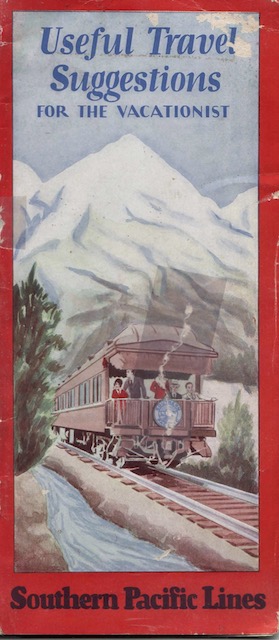This booklet 34 possible rail tours around the western United States (including a few to Mexico), most of which start at Chicago, New Orleans, or St. Louis. Actually, there are many more than 34 as most of the tours come with one or more alternate routes. The booklet also mentions (and includes fares for) various possible side trips, including to Juneau or Skagway, Alaska and tours of various national parks.
 Click image to download an 11.7-MB PDF of this 44-page booklet.
Click image to download an 11.7-MB PDF of this 44-page booklet.
For example, tour 5 began in New Orleans, went to Los Angeles, Seattle, Vancouver, through the Canadian Rockies to Chicago, and then back down to New Orleans. The basic route cost $118.88. A side trip to the Apache Trail in Arizona added $10. A side trip to Carriso Gorge in California added $6. Side trips to Sequoia, Yosemite, or Crater Lake national parks added $12 to $45. A steamship to Skagway and back was $90.
Multiply all of these figures by 17 to get today’s dollars. That would bring the basic trip up to about $2,000. Basic fares are for transportation only and do not include meals and don’t appear to include sleeping accommodations. Some of the side trip costs, such as for Alaska steamships and some national park tours, may include hotel or camp accommodations and meals.
This booklet is dated March 1930, just four months after the Wall Street crash of 1929. Intercity passenger travel by train had already declined by 40 percent since 1920 and would fall 50 percent more between 1929 and 1932. Did Southern Pacific put out this booklet to assure people they could still take low-cost vacations by train? Or was it completely oblivious to the fact that most Americans couldn’t afford a family vacation that, in today’s money, would cost thousands of dollars?
One clue is in the fact that it optimistically mentions the “Alturas route” as “the new highway to the north Pacific Coast, extending from Ogden to Portland.” I mentioned this route a few weeks ago because it was shown in a map on the cover of a 1957 timetable. Bill M. commented that SP ran trains on this route starting in September 1929, but it took 23 hours longer than the Union Pacific route from Portland to Ogden, and so the through trains ended after two years. Perhaps if the Depression hadn’t intervened, SP might have developed this route to be more competitive.

Canadian Pacific ran a full slate of summer trains in 1930. There were 2 through trains from Vancouver to Montreal, 2 to Chicago, 1 to Toronto, and 1 via the Crowsnest Pass to Medicine Hat: the same as in 1929. It wasn’t until later in 1930-31 that service was cut back significantly.
It seems that some other railways may also have had similarly full schedules in the summer of 1930, suggesting that the full impact of the stock market crash had not yet affected people…at least not those who had the means to travel first-class by train.
Even looking at the Erie Railroad (which was probably more dependent on a healthy industrial economy, and much less on tourists)…in April of 1929, when their premier train the Erie Limited was launched, there were 4 named trains from New Jersey to the Midwest (3 to Chicago, with sections to Buffalo, Cleveland, and Cincinnati).
They continued running all 4 trains all the way through 1930, right up until September 1931, when the Cincinnati section of one train was cut, with the whole 4th train finally being dropped in April 1933.
I was surprised when first discovering these old timetables, that it took a year or two for the railways to modify their schedules in light of economic changes…so they must have been doing okay at first, in spite of the long-term toll that we know the downturn took on peoples’ lives and livelihoods.